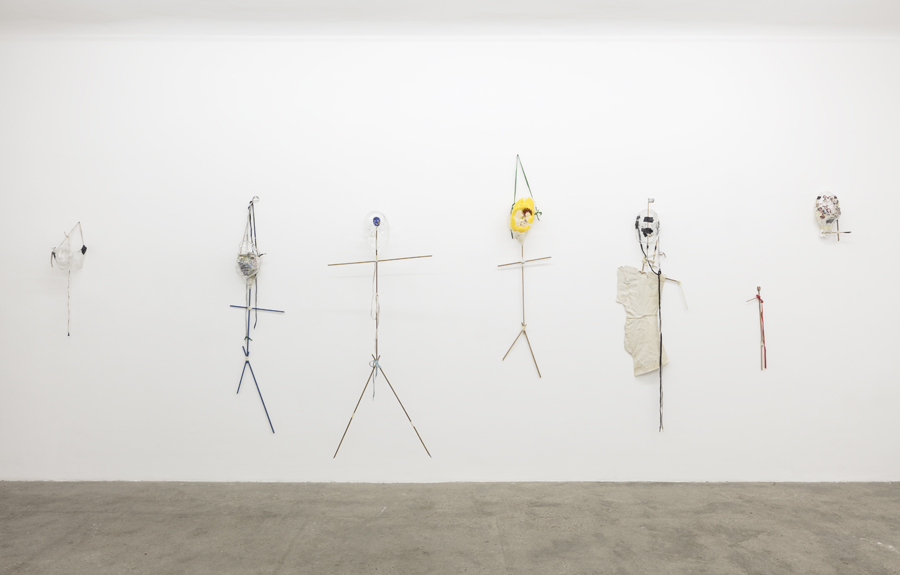Win McCarthy
Silberkuppe, Berlin, Germany
Silberkuppe, Berlin, Germany

Why might one map the past? Why might one physically reconstruct memories? To reanimate, perhaps, in order to relive, re-examine or excise; to deconstruct experience and unearth a blueprint for the good, bad and in between. For the amnesiac narrator of Tom McCarthy’s novel Remainder (2005), who assembles scale models of the few memories that endure, it is to ‘feel real again’. He is, however, wary – not of the accuracy of his facsimiles, but of the cognitive foundations upon which they are built. ‘But who’s to say these are genuine memories? […] Minds are versatile and wily things.’ That’s another reason: to safeguard against one’s own self.

The press release for Win McCarthy’s exhibition ‘Mister’ opens with a familiar, dreaded imperative: ‘FOR ASSEMBLY’; the show itself, with our first set of components, lain flat and primed for construction: a twist of red shoelace, tracks of masking tape, wooden sticks, their bound angles a Mondrian-style right. These parts are small, and there are no instructions, but we do have machinery (a model crane: legs wide, neck long) and we do have friends: ‘Lola, Harry, Addie, and Robert B’. They are just photographs, unfortunately, their names jotted on the press release, but they might be of help, as mementos often are. The artist is also on hand: a glass mask placed flat.

This 1:50 construction yard, the title of which catalogues the components and timestamps the memory that is being reconstructed (‘Feb 22’), is flanked by a wall-mounted linen body – legless, topped with another mask – and a diorama: January '17 calendar (Der Fuß des Künstlers) (all works 2017). This date is visualised by a partitioned foam-board maquette resembling the floor plan of a soulless office, or a laboratory maze. Stuffed between yellowing dividers are a photographic swarm of memories: friends, avenues, the artist’s titular foot. These are broken down, blown up, pieced together fragments of a past that, like the distorted ‘2017’ that is stamped in the work’s top right corner, slowly loses wholeness, floating into a haze of partial recollection.

In Silberkuppe’s rear room is a sibling-piece, March ’17 calendar (bits and pieces), its dividing walls not yet erected, its characters (summoned again via passport-sized snapshots) fixed, preserved, imprisoned, with pins, like butterflies. Then comes a second assembly project (a.Incomplete ’17 calendar [Fridge Contents] b.Misc. wooden sticks c.Glass mask [Scream] d. Shoelace) and, dangling along a nearby wall, a cast: voodoo-like effigies of those figures of March or February. Their names remain partially constructed – Headless, Imogen (Blue World), Shattered Mask – as do their forms. Bodies are all but lost to the progression of time, replaced with bound wooden canes; heads are all of glass, with features either sagging or peppered with further photographs of friends, as if to atone for the artist’s inability to recall specifics.

Memories will remain as and when they themselves see fit to do so. Try to control that process and everything will change: the automatic becomes unnatural. It’s something like remembering you’re breathing; something like remembering you’re blinking; or, as McCarthy’s press release attests: ‘Something like / A clock remembering, / Suddenly, / It’s own ticking’. Can we, then, regard these attempts at self-archaeology, -assessment, -preservation, or whatever they may be, as successful? We cannot. For these personal cartographies are flimsy, foggy, fading; the few examples of clear recollection diluted by abundant nothingness. But we should be optimistic about these shortcomings: life is, always will be, a beautiful mess – inscrutable and, yes, utterly irretrievable. And therein lies its charm. We must abandon hope of control, move as we do and enjoy it.
Main image: Win McCarthy, ‘Mister’, 2017, installation view, Silberkuppe, Berlin. Courtesy: Silberkuppe, Berlin; photograph: Timo Ohler























